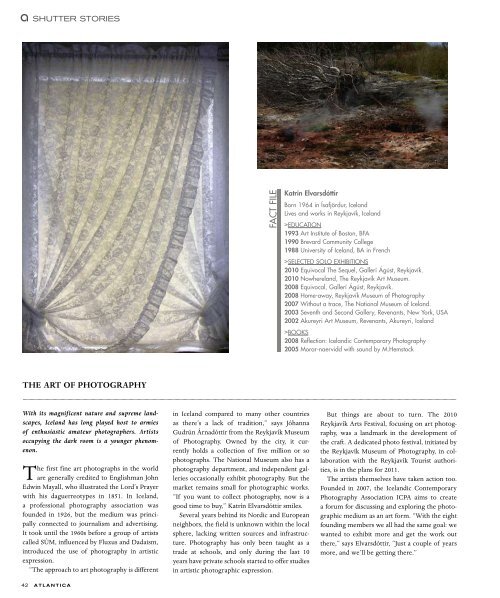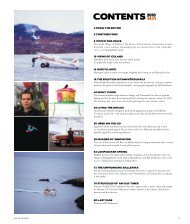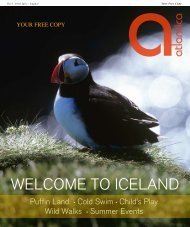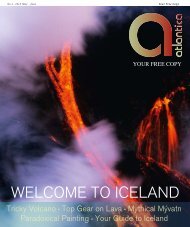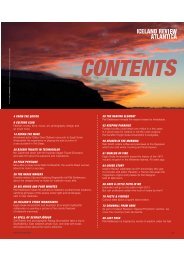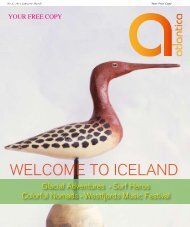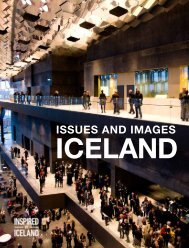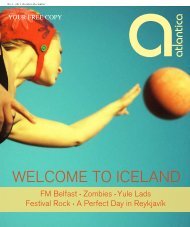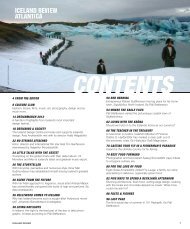Atlantica - Iceland Review
Atlantica - Iceland Review
Atlantica - Iceland Review
You also want an ePaper? Increase the reach of your titles
YUMPU automatically turns print PDFs into web optimized ePapers that Google loves.
a SHUTTER STORIES<br />
FACT FILE<br />
Katrín Elvarsdóttir<br />
Born 1964 in Ísafjördur, <strong>Iceland</strong><br />
Lives and works in Reykjavík, <strong>Iceland</strong><br />
>EDUCATION<br />
1993 Art Institute of Boston, BFA<br />
1990 Brevard Community College<br />
1988 University of <strong>Iceland</strong>, BA in French<br />
>SELECTED SOLO EXHIBITIONS<br />
2010 Equivocal The Sequel, Gallerí Ágúst, Reykjavík.<br />
2010 Nowhereland, The Reykjavík Art Museum.<br />
2008 Equivocal, Gallerí Ágúst, Reykjavík.<br />
2008 Home-away, Reykjavík Museum of Photography<br />
2007 Without a trace, The National Museum of <strong>Iceland</strong>.<br />
2003 Seventh and Second Gallery, Revenants, New York, USA<br />
2002 Akureyri Art Museum, Revenants, Akureyri, <strong>Iceland</strong><br />
>BOOKS<br />
2008 Reflection: <strong>Iceland</strong>ic Contemporary Photography<br />
2005 Morar-naervidd with sound by M.Hemstock<br />
THE ART OF PHOTOGRAPHY<br />
With its magnificent nature and supreme landscapes,<br />
<strong>Iceland</strong> has long played host to armies<br />
of enthusiastic amateur photographers. Artists<br />
occupying the dark room is a younger phenomenon.<br />
The first fine art photographs in the world<br />
are generally credited to Englishman John<br />
Edwin Mayall, who illustrated the Lord’s Prayer<br />
with his daguerreotypes in 1851. In <strong>Iceland</strong>,<br />
a professional photography association was<br />
founded in 1926, but the medium was principally<br />
connected to journalism and advertising.<br />
It took until the 1960s before a group of artists<br />
called SÚM, influenced by Fluxus and Dadaism,<br />
introduced the use of photography in artistic<br />
expression.<br />
“The approach to art photography is different<br />
in <strong>Iceland</strong> compared to many other countries<br />
as there’s a lack of tradition,” says Jóhanna<br />
Gudrún Árnadóttir from the Reykjavík Museum<br />
of Photography. Owned by the city, it currently<br />
holds a collection of five million or so<br />
photographs. The National Museum also has a<br />
photography department, and independent galleries<br />
occasionally exhibit photography. But the<br />
market remains small for photographic works.<br />
“If you want to collect photography, now is a<br />
good time to buy,” Katrín Elvarsdóttir smiles.<br />
Several years behind its Nordic and European<br />
neighbors, the field is unknown within the local<br />
sphere, lacking written sources and infrastructure.<br />
Photography has only been taught as a<br />
trade at schools, and only during the last 10<br />
years have private schools started to offer studies<br />
in artistic photographic expression.<br />
But things are about to turn. The 2010<br />
Reykjavík Arts Festival, focusing on art photography,<br />
was a landmark in the development of<br />
the craft. A dedicated photo festival, initiated by<br />
the Reykjavík Museum of Photography, in collaboration<br />
with the Reykjavík Tourist authorities,<br />
is in the plans for 2011.<br />
The artists themselves have taken action too.<br />
Founded in 2007, the <strong>Iceland</strong>ic Contemporary<br />
Photography Association ICPA aims to create<br />
a forum for discussing and exploring the photographic<br />
medium as an art form. “With the eight<br />
founding members we all had the same goal: we<br />
wanted to exhibit more and get the work out<br />
there,” says Elvarsdóttir, “Just a couple of years<br />
more, and we’ll be getting there.”<br />
42 atlantica


